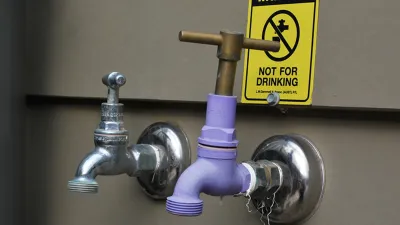Pretty Prairie has water with very high levels of nitrates, and lots of farmers that need to use nitrates if they want to keep the local economy going.

This month’s issue of Harper’s has a long piece by Elizabeth Roye that’s worth reading just for its exploration of how difficult it is for rural areas to provide clean drinking water for their small populations when their way of life is already threatened.
It takes place in Pretty Prairie, Kansas, where the content of nitrates in the water—due to fertilizer used on farmland that comprises over 90 percent of the land—has, for decades, exceeded the limits established by the EPA.
A reverse-osmosis plant has always been only barely feasible economically, but as Royte learns, trying to get the farmers to stop using as much fertilizer is an equally challenging proposition: “Less fertilizer means lower yields, and if farmers earn less, they might default on loans, exacerbating the shrinking of the town.”
In the end, a place with 320 ratepayers has now borrowed enough to build a plant that can remove nitrates from the water, and the town clerk tells Royte, with relief, that they will never have to worry about water again.
“That may be true,” Royte writes, “but I suspected Brace’s sense of relief—and the community’s—was related more to social, rather than civil, engineering. A decision had been made: the farmers would do their best, within the bounds of their economies, and the townsfolk—with a onetime boost from the feds—would continue uncomplainingly to clean up after them.”
FULL STORY: Drinking Problems

National Parks Layoffs Will Cause Communities to Lose Billions
Thousands of essential park workers were laid off this week, just before the busy spring break season.

Retro-silient?: America’s First “Eco-burb,” The Woodlands Turns 50
A master-planned community north of Houston offers lessons on green infrastructure and resilient design, but falls short of its founder’s lofty affordability and walkability goals.

Delivering for America Plan Will Downgrade Mail Service in at Least 49.5 Percent of Zip Codes
Republican and Democrat lawmakers criticize the plan for its disproportionate negative impact on rural communities.

Test News Post 1
This is a summary

Test News Headline 46
Test for the image on the front page.

Balancing Bombs and Butterflies: How the National Guard Protects a Rare Species
The National Guard at Fort Indiantown Gap uses GIS technology and land management strategies to balance military training with conservation efforts, ensuring the survival of the rare eastern regal fritillary butterfly.
Urban Design for Planners 1: Software Tools
This six-course series explores essential urban design concepts using open source software and equips planners with the tools they need to participate fully in the urban design process.
Planning for Universal Design
Learn the tools for implementing Universal Design in planning regulations.
EMC Planning Group, Inc.
Planetizen
Planetizen
Mpact (formerly Rail~Volution)
Great Falls Development Authority, Inc.
HUDs Office of Policy Development and Research
NYU Wagner Graduate School of Public Service



























